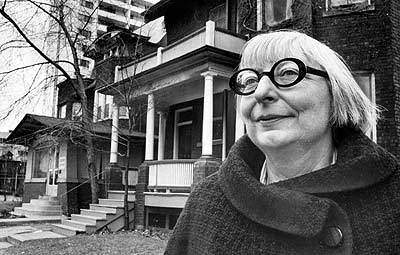Jane Jacobs thought intensely about Detroit. Almost a decade after her death, the shadow of Jane Jacobs keeps growing as architects, urban planners and city makers discover (and worship) her acute understanding of how cities work. We owe Jane Jacobs the exploit of placing humans at the center of urbanism, in a time where cities were planned, designed and built for cars.
Jane Jacobs wrote her most renowned books during the splendour age of Detroit. Her disruptive ideas were the product of close observation, deep reasoning and naïf romanticism. Just like Einstein’s theories about relativity came too early to be tested, Jane Jacobs thoughts about cities were formulated with decades of anticipation. Fifty years after urban practitioners from around the globe witness in awe how her predictions have materialized.
The rise and fall of Detroit
“Death and Life of the great American cities” is one of the greatest books about cities ever. Despite its style, concepts and narrative flow, despite being written by a city activist turned lately into a brilliant urbanist, the book marvelously (or pityingly) anticipates the path that Detroit and other industrial rust belt cities undertook a decade later, and its final collapse.
In the second part of the book, Jacobs talks about how the only guarantee of success for our districts and cities is to foster diversity of uses. Mix of primary uses: offices, housing, culture, entertainment, parks and recreation, etc… are key to make our neighborhoods rich in activity and life.
Jane Jacobs studies those factors -present in Detroit- that destroy diversity and city life. The urban scars: railways, highways, industrial docks, the so-called “vacuum frontiers”… can be lethal for urban life since they cut inter-district pedestrian communication, causing in its surroundings a progressive decay of economic activity. Detroit’s urban planning has been made with the motor industry in mind. Mono-activity districts, lack of urban density, highways and railways intended to move people to and out of factories. An urban planning oriented to the outskirts, with the taxpayers being progressively evicted from the city ‘s administrative boundaries and into “suburbia”, and a city center that progressively loses commercial activity, and taxes. A death spiral.
Industries, taxes, commercial activity, real-estate, construction… all economy sectors (not to mention tourism, almost a sarcasm in Detroit) losing ground in a domino effect, and leading to ultimately turning Detroit in the first city to enter bankruptcy at the beginning of the 21st century.
The economy of Detroit
Almost a decade after publishing her revolutionary work “Death and Life of the Great American Cities”, Jane Jacobs published in 1969 “The economy of cities”, an attempt to explain in a simple way how wealth in cities is generated.
The central idea of the book is pretty simple: according to Jacobs, only innovation is a sustainable engine to create wealth and to fuel the expansion of the economy of a city, since only innovation is able to create products and services than can be exported by the city, and therefore fund, not only acceptable urban life conditions, but also the development of new innovations. She argues that big corporations are the product of a creative past, not a guarantee of an innovative future, warning us against urban planners and politicians that shape the economy and tailors urban landscape and infrastructures solely with those big companies in mind, anticipating the collapse of Detroit in an astounding, visionary way. The footprint of Detroit’s creative past was the succesful city of the 60’s were (as in Florence during the renaissance) excess capital and talent could water artistic expressions like the Motown record industry.
But, maybe our preferred chapter is “The valuable inefficiencies and impracticalities of cities”. In it, the author argues that the maximum size of a city is a relative magnitude, that varies with with technological progress and increases as a a function of time. But the actual growth of a city is also a mirror of its success. Detroit’s dramatic loss of population in the last forty years is a measure of the failure of a city to keep being innovative, and the emptying of its city downtown is the mirror of a profoundly misguided urban planning strategy and an erroneous understanding of how city economics functions.
Very often, Jacobs argues, innovation happen at small enterprises created by former employees of bigger corporations that decide to adventure in their own businesses, possibly to experiment or work in innovative ideas that they are not allowed to implement in their (strict) big organizations. This is precisely how the motor industry was created. According to Jane Jacobs, at the blossoming of the motor industry in Detroit (beginning of the 20th century), hundreds of small motor firms were flourishing out of spin-outs, spin-offs and techno-mechanical start-ups.
Detroit’s renaissance
Although many problems persist (insecurity, urban tissue disintegration), low rents and availabaility of space are beginning shift the perception of Detroit into an acceptable place for investors. The city has left behind its situation of bankrupcy and is slowly recovering ground. A century after, start-ups are beginning to blossom again, this time surfing the digital wave. It is important, Jacobs pointed out, that the city tolerates these spin-offs processes and that it facilitates the necessary conditions so the new innovative business can survive. This is exactly the idea behind many of the start-up incubators that nowadays populate our cities, and the idea behind Grow Detroit, the initiative that pulls together the city’s start-up community.
With the motor industry regaining sales due to the recovering of Western economies, new partnerships between the old automobile giants and the high-tech entrepreneurs are being sealed. In terms of urban planning, the spirit of Jane Jacobs also glides over the newly projected tramway that, as opposed to the infrastructures of the past intended to isolate and evict people out, will cross the city center and could possibly bring life back.
Whether this will lead or not to a renaissance of the old-battered Detroit will ultimately depend on the ability of its governing forces to stay away from the temptation of putting again all the eggs in the same basket. For the time being, it seems that Detroiters are recovering some of their lost pride, even timidly venturing to organize their first Jane Jacobs walk.
This article is published under a Creative Commons license. Some rights reserved.














